Popular domestic and unusual breeds of hamsters

If you have dreamed of having a pet for a long time, but there is not enough space in your apartment for a dog or a cat, a hamster will be the perfect solution. A small, mobile animal does not require complex care, and if handled correctly, it can become a real friend. It is interesting to watch hamsters of any breed: they stuff their cheeks with food, clean their faces, run in a wheel - these are very fussy and active animals. But in order for you to be able to make friends, you need to study the characteristics of the behavior and content of the hamster.
Among the popular domestic breeds, it is better to choose the one that will be easier for you to care for. And for exotic lovers, it is important to know the specifics of unusual breeds of hamsters and which ones should not be kept at home.


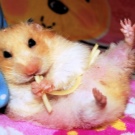



Peculiarities
The hamster belongs to the order of rodents - these are small animals with short legs and tails, as well as small ears. Despite the fact that there are about 19 of their species, they are all similar to each other, but differ only in size and color, which depend on the habitat. Thus, the inhabitants of the desert plains received a coat of yellow or sandy shade. Hamsters living in the forest-steppe zone got a brown or gray skin. And the rocks have a black or dark brown coat color. This allows tiny animals to safely camouflage themselves from attacks of aerial predators.
Nature has endowed hamsters with sharp and strong teeth that enable them to cope with hard foods such as nuts and grains. The animal has only 4 teeth, which grow throughout its life. Therefore, when kept at home, he needs a special mineral stone, about which he will grind his teeth.



The hamster's diet is quite extensive, it includes:
- cereals and legumes;
- vegetables;
- fruits;
- roots;
- herbs;
- berries;
- nuts;
- seeds.


Certain species, such as the Transbaikalian and rat-like hamster, also feed on insects and carrion. In its natural environment, the hamster has access to food only in the summer-autumn period, so the animal of any breed will definitely be stocked up for future use. To do this, he has special cheek pouches that allow you to store food and transfer supplies to storage.
So, we can conclude that a hamster needs a fairly rich diet to provide the body with the necessary elements. As a basis for a pet's diet, a special feed mixture, additionally enriched with vitamins, is perfect. In the summer, hamsters need to get fresh vegetables, fruits, berries and greens. For this, the following are suitable:
- carrot;
- broccoli;
- radish;
- apples;
- pears;
- apricots;
- Strawberry;
- blueberry;
- currant;
- dandelion;
- Clover;
- lettuce leaves.



Proper nutrition plays an important role in your pet's well-being. Never give your hamster dairy products, sweet pastries, or certain types of vegetables and fruits. Here is a list of foods that are prohibited for domestic rodents.
- Dairy products (sour cream, yogurt, milk, kefir). They can cause digestive upset, which can be fatal to your hamster.
- Flour products (bread, rolls), Such food leads to diseases of the internal organs and can cause bloating.
- White cabbage. Its use threatens poisoning and intestinal upset.
- Citrus fruit. Tangerines and oranges can cause allergic reactions and even cancer.


Hamsters are used to getting the required amount of water from food, because in their natural habitat they rarely have access to a water source. However, the presence of a drinking bowl with water in the pet's cage is still necessary. Depending on the air temperature and the food received, the rodent will be able to get additional moisture if necessary.
Wild rodents are territorial animals, they live alone in underground burrows. Therefore, two individuals of the same sex cannot get along in one cage. Hamsters are nocturnal. In their natural environment, at night they go in search of food - so the animal is less likely to get caught in the clutches of a predator, such as a weasel or a heron. Be prepared for your pet to spin the wheel and rustle with sawdust most of the night.
The life span of a wild hamster is 1-2 years. A domestic rodent with proper care can live for more than 3 years.

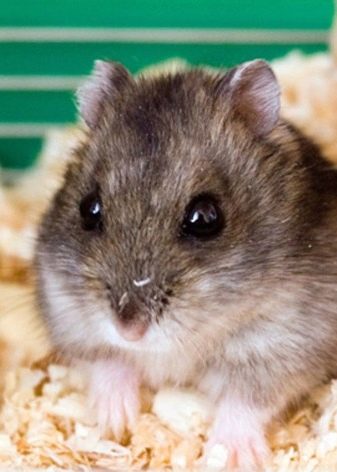
Popular breeds
Despite the ease of care, each type of domestic rodent has its own characteristics. Before choosing the breed of a future pet, you should take into account the habits inherent in its representative. This will help you to quickly gain confidence in the tiny and shy by nature animal.
It is believed that the life expectancy of a hamster who is friends with the owner is much higher. After all, so he is less likely to experience stress, which affects the general condition of the body.

Below are the most common domestic hamster breeds with a brief description.
Chinese
Representatives of this breed most often have a brown coat with an ash tint, their weight is about 50 grams, and their length varies from 8 to 12 centimeters. They feed on insects and grains. They are distinguished by a friendly character - after taming, they actively make contact with the owner and strive for communication. In addition, this is one of the few breeds that allows the keeping of several individuals in one cage.
Representatives of this breed have a decorative variety - it is distinguished by a white or spotted color.

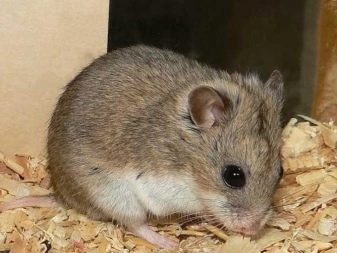
Syrian
The Syrian breed is one of the most popular for its friendly disposition and easy grooming. In some cases, their life expectancy can reach 6 years. However, the representatives of the Syrian breed do not tolerate neighbors in the cage. Their feature is also that they are less active at night. Among the decorative varieties of the Syrian breed, one can distinguish Angora, one-color and golden. The Angora hamster has long and fluffy white or red hair, which requires special care.
Sometimes this fur-bearing Syrian is called royal, although there is no separate breed called “royal”. A monochromatic hamster is completely black or white in color. The golden coat has a soft peach coat of medium length.


Gray
The gray hamster reaches a length of 13 centimeters. The color of the coat ranges from light gray to smoky or brownish gray. At the same time, their abdomen and legs are white, and the tail, the length of which can reach 3 centimeters, is slightly pubescent or naked. Prefers seeds and insects in food. This animal also loves succulent plants.
It has a sensitive digestive system, when choosing this breed, you should carefully monitor the quality of the feed and the purity in the cage.

Dzungarian
Representatives of this breed do not grow more than 10 centimeters in length. Their color varies from brown to gray and light brown. The abdomen is always lighter, and on the back there is a black stripe. They are especially active at night. In the wild, seeds and greens are preferred. They are very friendly from the first days of their acquaintance, they rarely bite. When replacing sawdust once a week there is absolutely no smell from them.
Dzungarian hamsters are incredibly lively - they should not be let out for a walk around the room without a ball, as they can quickly slip out of sight. This type of rodent belongs to the Upland.
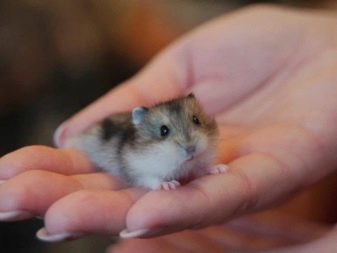

Roborovsky's hamster
Just like the Dzungarian, it belongs to the Uplifted. It is distinguished by its tiny size - the length of a rodent of this breed does not exceed 5 centimeters. The coat is gray with white spots. Representatives of this breed are friendly not only to humans, but also to their own kind. Coexistence of several individuals is permissible. Due to their agility and tiny size, it is not recommended to let them go for a walk without a special ball.


Campbell's Hamster
One of the few species whose wild representatives do not live alone, but in a colony. This dwarf breed, not exceeding 10 centimeters in length, is classified as Upland. The coat is golden with a dark stripe on the back. The peak of activity occurs at night and in the morning. However, representatives of this breed have fragile health. They are prone to diseases such as cancer, diabetes and cataracts.
If you decide to breed these rodents, be prepared to pay special attention to their health. Also, Campbell's hamsters are difficult to tame and often bite, so they should not be taken by families with children.


Sungur
The Sungurian hamster is another type of dwarf breed that belongs to the Upland. Its length reaches 8 centimeters, the coat is smoky in color. Extremely active at night. He is friendly to people and gets along with other representatives of his breed, however, in the case of cohabitation, fights and skirmishes can occur.
If you are giving this baby fresh fruits and vegetables, you need to be careful not to make "stashes" out of them, as eating stale food can lead to digestive upset. Prone to overeating.

Siberian hamster
A dwarf breed, the length of which does not exceed 9-10 centimeters, and the weight is 40 grams. The peak of activity of "Siberian", as in most representatives of the species, falls at night. The coat is silvery with a blue tint with a black stripe on the back, due to which it is often confused with the representative of the Dzungarian breed. By winter, the color of the hamster turns white. Does not tolerate neighborhood, difficult to tame.

So, we can conclude that despite the similarity of habits and lifestyle, there are nuances in caring for each breed of hamsters... For families with children, it is better to choose the friendlier breeds.However, even the most contact and sociable animals require a special approach and respect. If you bought a hamster for a child, do not leave it alone with a rodent until they get used to each other and the child learns to handle it carefully.
Species with poor health should be started only if there is a veterinarian in your city who can cure such a baby. Unfriendly breeds should be purchased if simple observation of your pet is enough for you. Such a hamster will perceive any attempt at contact as a danger, it is better not to disturb him without a good reason, such as replacing the filler.

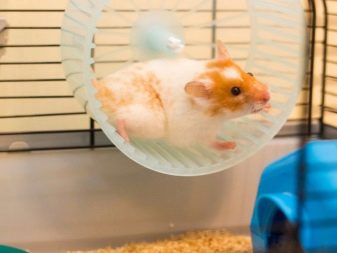
Unusual views
In addition to the fluffy friendly babies familiar to humans, there are also special breeds of hamsters in nature. Some of them look almost the same as at home, but differ in aggressive behavior, others have unusual external signs, but at the same time a good-natured disposition, and still others have distinguished themselves in all respects. One way or another, all these rodents are changing the way we think about hamsters, their appearance and way of life.

Below are the exotic breeds of hamsters with a brief description that you are unlikely to find in a simple pet store.
Grasshopper, aka scorpion hamster
This harmless-looking animal is not much different from domesticated species, but its appearance is very deceiving. The length reaches 14 centimeters with the tail, and the weight is only 50-70 grams. Color - red with dark brown. Despite its diminutive size, this animal is an absolute predator! He hunts at night, his diet is based on rats, mice, lizards and insects. But this is not all of its unusual qualities - a representative of this breed, thanks to its genetics, is not at all afraid of pain and has resistance to poisons.
For example, scorpion venom acts as an invigorating drink for a hamster. It was this feature that gave him his second name "scorpion".

African hamster
This animal looks like a hedgehog or porcupine. Compared to domestic species, it is distinguished by its large size - from 25 to 35 centimeters in length, and the weight of an adult can reach a kilogram. The coat is thick and long, with a characteristic mane along the spine, due to which it is also called "shaggy". The color is black and dark brown with white spots.
The peculiarity of this rodent is that, sensing danger, it sprays odorous poisonous substances from its lateral glands. In most cases, a predator that tries to attack a shaggy hamster dies from a high dose of toxins.

Eversmann's hamster
This thoroughbred rodent is named after the naturalist Eduard Eversmann. In habits and appearance, it practically does not differ from its domesticated counterparts, however, due to its low number, this species is listed in the Red Book. The external features of the animal are gray-red fur with a white belly, size up to 16 centimeters in length. Its maintenance and care are the same as that of the Dzungarian hamster. The animal is generally friendly, but sometimes it can bite.
This happens more often if the hands smell like food. That's why It is not recommended to hand feed a representative of this breed, as in this case he will associate the smell of his owner with the smell of food.
At home, the rodent is prone to obesity, so it is important not to overfeed it.

Albino hamster
Albinism is a gene mutation that can occur in any breed, be it Syrian or Chinese. Regardless of the species, such animals are distinguished by a white fur coat, as well as a pink nose and red beady eyes. In addition to its unusual appearance, the albino animal has more fragile health. He is prone to skin and eye diseases, stress is more difficult.
Such a snow-white baby with red eyes must be protected from direct sunlight, since the retina of an albino eye is not adapted to bright light. It is better to put a cage with it away from windows.

Common hamster
This wild relative of our pets is large - about 35 centimeters, and the tail is about 6-7 centimeters long. The fur coat of the animal is of a rich brown color with white splashes, and the abdomen is black. This species is difficult to tame, more suitable for observation than for contact communication.
If you decide to have a wild hamster at home, you should take care of a spacious home for him. A cage designed for a decorative rabbit is more suitable for him. It is also necessary to find a wheel of the correct size - with a lack of physical activity, this animal is more likely to get sick and its life expectancy decreases.
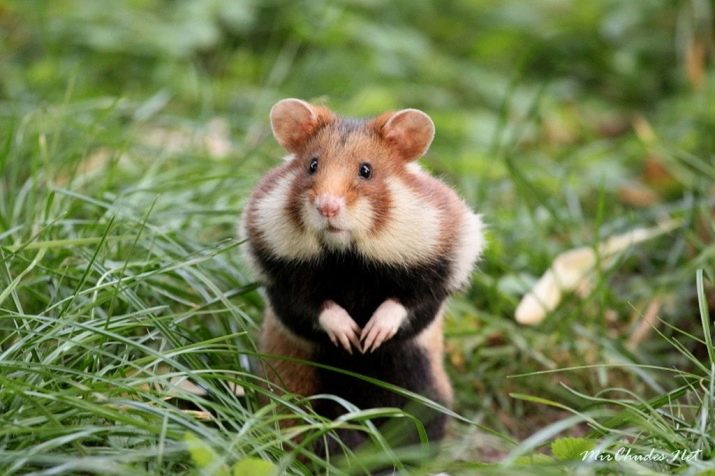
Rat hamster
This rodent is distinguished by its larger size in comparison with domestic species, and a long bald tail, which makes it look like a rat. You can understand that this is still a hamster by its color - a dark brown skin is not typical for the mouse family. The weight of the animal is about 250 grams, and in length it can reach 25 centimeters. This is an unfriendly species that does not lend itself well to domestication; it is extremely rarely kept as a pet.
If you nevertheless decide to purchase this rodent, it is important to provide him with comfortable conditions, namely a spacious cage and balanced nutrition.
You should not get a representative of this breed in a family with small children, as he will experience stress from noisy games and excessive attention.

Hamster Radde
The breed was discovered by the Russian naturalist Gustav Radde and named after him. Its length can reach 28 centimeters, the color is dark brown and gray with white spots. This species is not intended for home keeping, since the animal is difficult to tame, but you can find an approach to it if you have patience. Able to accept only one person amiably.
The second name of this breed is "Dagestan", since the halo of its habitat is the foothill regions of the Caucasus.

So, each exotic breed has its own terrifying or surprising features for us. It is better to refuse to breed them at home, because the maintenance of exotic hamsters, as a rule, requires more significant financial costs, and some of them are listed in the Red Book. It should be understood that the acquisition of such rodents is a big responsibility. If a representative of one of the wild breeds gets sick, you simply cannot find a qualified specialist to help the animal.
Breeding wild hamsters is only worthwhile if you have special knowledge about them or have a scientific interest in exotic species.

How to choose a hamster?
When choosing a hamster, the first step is to decide on its breed. If you want a friendly pet - give preference to popular breeds for home breeding... If you like to observe rodents and study their behavior, and also you know how to help the baby in case of illness, you can consider wild breeds. For families with small children, it is best to choose easily tame varieties.
And if one of the family members is allergic to wool, pick up a pet of a hypoallergenic breed, such as the Syrian or Dzungarian.

Below are the main parameters to help you make the right choice.
- Age. It should not be less than 3 weeks old. This is due to the hamster's need for breast milk, because such a baby does not yet have the skill of self-feeding. A female older than 2 months can easily be pregnant, since the pet store often contains a large number of heterosexual rodents in one cage. A hamster between 3 weeks and 2 months of age is easier to tame. You can determine the age of the future pet by paying attention to the teeth - over time, they noticeably turn yellow.
- Floor. Males are calmer and friendlier in character. However, in the wild, they are used to marking their territory, therefore, there will be more smell from them - males often need to replace the filler.Females are more hot-tempered, but also more active - it is more interesting to watch them. You can determine the sex of a hamster by carefully examining its lower part. In the female, the distance between the anal and vaginal opening is insignificant, in addition, she has less hair in the lower abdomen.
- Time of purchase... Since hamsters are nocturnal, it is easier to assess the activity and character of the future pet in the evening. If you come to a pet store in the evening, you can see active and friendly animals, and not sleeping lumps of fur. This will make it easier to choose a friend with a similar temperament.
- Health status. Of course, when buying a hamster, you cannot be 100% sure that it is completely healthy. But clear signs of disease can still be noticed. Pay attention to the coat - it must be dry, clean and smooth, without bald spots. The eyes and nose should also be clean and free of discharge.
- Activity... Hamsters are by nature very mobile and nimble. If the animal, despite the evening hour and comfortable conditions of detention, barely moves, preferring to lie in the corner of the cage, this may also be a sign of illness.
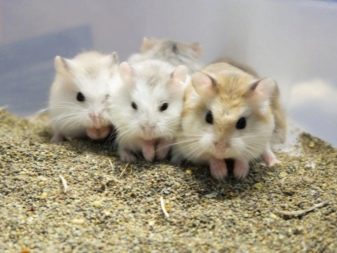

After buying a hamster, it is better not to touch it for 24 hours. During this time, the baby will be able to get comfortable in a new place and then the acquaintance will be much more pleasant for both of you. In the further taming, be guided by the principle "the quieter you drive, the further you will be." Take gradual steps towards rapprochement, inspiring more and more trust and less and less fear in your new friend, avoid sudden movements in communication with him.
If you follow these rules, it will be easy and pleasant for you to take care of the hamster, and it will be comfortable and safe with you.

For even more information on hamster breeds, see the next video.








